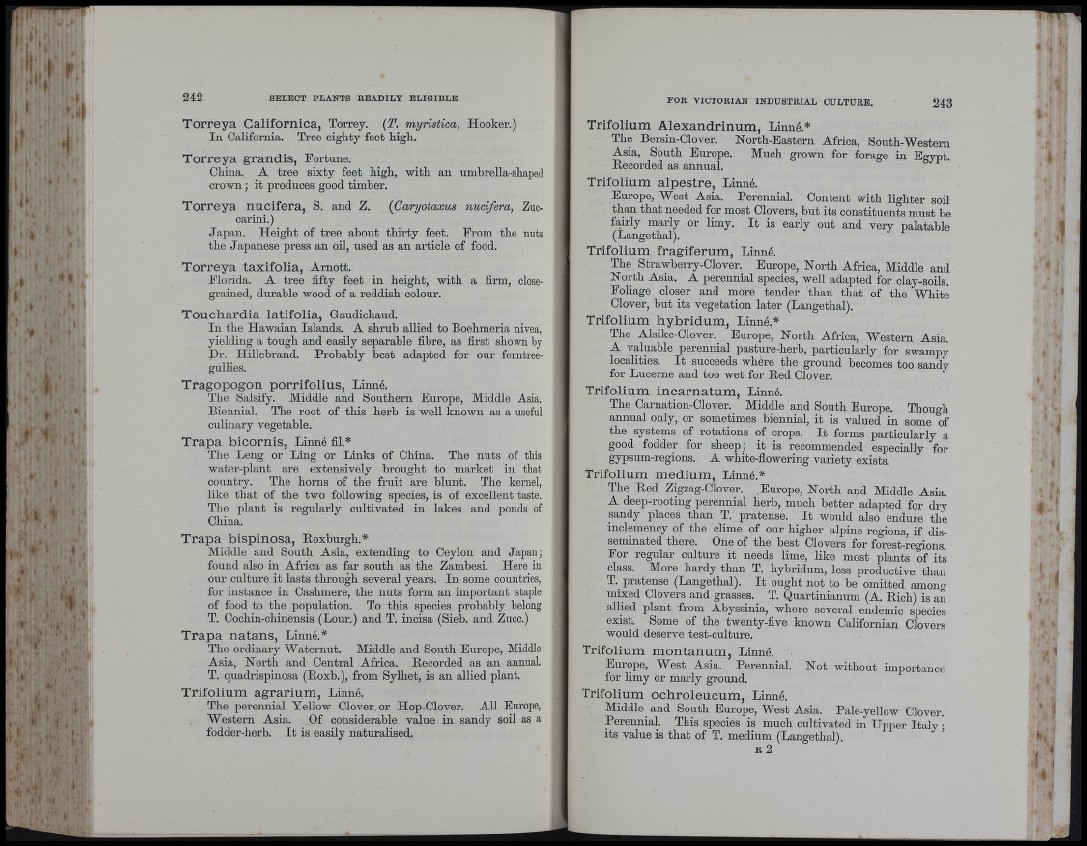
Torreya Californica, Torrey. {T. myristica, Hooker.)
In California. Tree eighty feet high.
Torreya grandis, Fortune.
China. A tree sixty feet high, with an umbrella-shaped
crown ; it produces good timber.
Torreya nucífera, S. and Z. {Garyotaxus nucífera, Zuccarini.)
Japan. Height of tree about thirty feet. From the nuts
the Japanese press an oil, used as an article of food.
Torreya taxifolia, Arnott.
Florida. A tree fifty feet in height, with a firm, close-
grained, durable wood of a reddish colour.
Toucliardia latifolia, Gaudichaud.
In the Hawaian Islands. A shrub allied to Boehmeria nivea,
yielding a tough and easily separable fibre, as first shown by
Dr. Hillebrand. Probably best adapted for onr ferntree-
gullies.
Tragopogón porrifolius, Linné.
The Salsify. Middle and Southern Europe, Middle Asia.
Biennial. The root of this herb is well known as a useful
culinary vegetable.
Trapa bicornis, Linné fil.*
The Leng or Ling or Links of China. The nuts of this
water-plant are extensively brought to market in tbat
country. The horns of the fruit are blunt. The kernel,
like th a t of the two following species, is of excellent taste.
The plant is regularly cultivated in lakes and ponds of
China.
Trapa bispinosa, Roxburgh.*
Middle and South Asia, extending to Ceylon and Japan;
found also in Africa as far south as the Zambesi. Here in
onr culture it lasts through several years. In some countries,
for instance in Cashmere, the nuts form an important staple
of food to the population. To this species probably belong
T. Cocbin-chinensis (Lour.) and T. incisa (Sieb. and Zucc.)
Trapa natans, Linné.*
The ordinary Waternut. Middle and South Europe, Middle
Asia, North and Central Africa. Recorded as an annual.
T. quadrispinosa (Roxb.), from Sylhet, is an allied plant.
Trifolium agrarium, Linné.
The perennial Yellow Clover, or Hop-Clover. All Europe,
Western Asia. Of considerable value in sandy soil as a
fodder-herb. I t is easily naturalised.
Trifolium Alexandrinum, Linné.*
The Bersin-Clover. North-Eastern Africa, South-Western
Asia, South Europe. Much grown for forage in E»ypt.
Recorded as annual.
Trifolium alpestre, Linné.
Europe, West Asia. Perennial. Content with lighter soil
than that needed for most Clovers, hut its constituents must be
fairly marly or limy. I t is early out and very palatable
(Langethal).
Trifolium fragiferum, Linné.
The Strawberry-Clover. Europe, North Africa, Middle and
North Asia. A perennial species, well adapted for clay-soils.
Foliage closer and more tender than that of the White
Clover, but its vegetation later (Langethal).
Trifolium hybridum, Linné.*
The Alsike-Clover.^ Europe, North Africa, Western Asia.
A valuable perennial pasture-herb, particularly for swampy
localities. I t succeeds where the ground becomes too sandv
for Lucerne and too wet for Red Clover.
Trifolium incarnatum, Linné.
The Carnation-Clover. Middle and South Europe. Though
annual only, or sometimes biennial, it is valued in some of
the systems of rotations of crops. I t forms particularly a
good fodder for sheep; it is recommended especially for
gypsum-regions. A white-flowering variety exists.
Trifolium medium, Linné.*
The Red Zigzag-Clover. .Europe, North and Middle Asia.
A deep-rooting perennial herb, much better adapted for dry
sandy places than T. pratense. I t would also endure the
inclemency of the clime of our higher alpine regions, if disseminated
there. One of the best Clovers for forest-regions.
For regular culture it needs lime, like most plants of its
class. More hardy than T. hybridum, less productive than
T. pratense (Langethal). I t ought not to be omitted amon»
mixed Clovers and grasses. T. Quartinianum (A. Rich) is an
allied plant from Abyssinia, where several endemic species
exist. Some of the twenty-five known Californian Clovers
would deserve test-culture.
Trifolium montanum, Linné.
Europe, West Asia. Perennial. Not without importance
for limy or marly ground.
Trifolium ochroleucum, Linné.
Middle and South Europe, West Asia. Pale-yellow Clover.
Perennial. This species is much cultivated in Upper Italy •
its value is that of T. medium (Langethal).
R 2